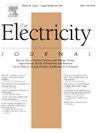Impact of Communication System Characteristics on Electric Vehicle Grid Integration: A Large-Scale Practical Assessment of the UK’s Cellular Network for the Internet of Energy
IF 2.2
Q1 Social Sciences
引用次数: 0
Abstract
The ever-increasing number of plug-in electric vehicles (PEVs) requires appropriate electric vehicle grid integration (EVGI) for charging coordination to maintain grid stability and enhance PEV user convenience. As such, the widespread adoption of electric mobility can be successful. EVGI is facilitated through charging stations and empowers PEV users to manage their charging demand by using smart charging solutions. This makes PEV grids assets that provide flexibility to the power grid. The Internet of Things (IoT) feature can make smooth EVGI possible through a supporting communication infrastructure. In this regard, the selection of an appropriate communication protocol is essential for the successful implementation of EVGI. This study assesses the efficacy of the UK’s 4G network with TCP and 4G UDP protocols for potential EVGI operations. For this, an EVGI emulation test bed is developed, featuring three charging parking lots with the capacity to accommodate up to 64 PEVs. The network’s performance is assessed in terms of data packet loss (e.g., the data-exchange capability between EVGI entities) and latency metrics. The findings reveal that while 4G TCP often outperforms 4G UDP, both achieve latencies of less than 1 s with confidence intervals of 90% or greater for single PEV cases. However, it is observed that the high penetration of PEVs introduces a pronounced latency due to queuing delays in the network including routers and the base station servers, highlighting the challenges associated with maintaining efficient EVGI coordination, which in turn affects the efficient use of grid assets.通信系统特性对电动汽车电网整合的影响:对英国用于能源互联网的蜂窝网络的大规模实际评估
随着插电式电动汽车(PEV)数量的不断增加,需要适当的电动汽车电网整合(EVGI)来协调充电,以维护电网的稳定性和提高PEV用户的便利性。因此,电动汽车的广泛采用可能会取得成功。EVGI通过充电站提供便利,并授权电动汽车用户通过使用智能充电解决方案来管理他们的充电需求。这使得PEV电网为电网提供了灵活性。物联网(IoT)功能可以通过支持通信基础设施使EVGI顺利实现。在这方面,选择合适的通信协议对于EVGI的成功实施至关重要。本研究评估了使用TCP和4G UDP协议的英国4G网络对潜在EVGI操作的有效性。为此,开发了EVGI仿真试验台,其中设有三个充电停车场,最多可容纳64辆pev。网络的性能是根据数据包丢失(例如,EVGI实体之间的数据交换能力)和延迟度量来评估的。研究结果表明,虽然4G TCP通常优于4G UDP,但对于单个PEV情况,两者的延迟都小于1 s,置信区间为90%或更高。然而,据观察,pev的高渗透率引入了明显的延迟,这是由于网络(包括路由器和基站服务器)中的排队延迟,突出了与维护有效EVGI协调相关的挑战,这反过来影响了网格资产的有效使用。
本文章由计算机程序翻译,如有差异,请以英文原文为准。
求助全文
约1分钟内获得全文
求助全文
来源期刊

Electricity Journal
Business, Management and Accounting-Business and International Management
CiteScore
5.80
自引率
0.00%
发文量
95
审稿时长
31 days
期刊介绍:
The Electricity Journal is the leading journal in electric power policy. The journal deals primarily with fuel diversity and the energy mix needed for optimal energy market performance, and therefore covers the full spectrum of energy, from coal, nuclear, natural gas and oil, to renewable energy sources including hydro, solar, geothermal and wind power. Recently, the journal has been publishing in emerging areas including energy storage, microgrid strategies, dynamic pricing, cyber security, climate change, cap and trade, distributed generation, net metering, transmission and generation market dynamics. The Electricity Journal aims to bring together the most thoughtful and influential thinkers globally from across industry, practitioners, government, policymakers and academia. The Editorial Advisory Board is comprised of electric industry thought leaders who have served as regulators, consultants, litigators, and market advocates. Their collective experience helps ensure that the most relevant and thought-provoking issues are presented to our readers, and helps navigate the emerging shape and design of the electricity/energy industry.
 求助内容:
求助内容: 应助结果提醒方式:
应助结果提醒方式:


